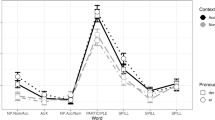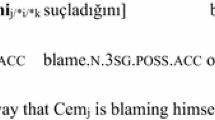Abstract
This paper examines the role that linguistic and cognitive prominence play in the resolution of anaphor–antecedent relationships. In two experiments, we found that pronouns are immediately sensitive to the cognitive prominence of potential antecedents when other antecedent selection cues are uninformative. In experiment 1, results suggest that despite their theoretical dissimilarities, topic and contrastive focus both serve to enhance cognitive prominence. Results from experiment 2 suggest that the contrastive prosody appropriate for focus constructions may also play an important role in enhancing cognitive prominence. Thus different types of linguistic prominence (topic, contrastive focus) appear to have the common effect of increasing the cognitive prominence of the discourse referent. For pronouns with two possible antecedents, the cognitive prominence of an antecedent aids in anaphor resolution, immediately biasing selection towards the more prominent (and ultimately preferred) antecedent.


Similar content being viewed by others
Notes
Conceptual prominence may be achieved without linguistic prominence, of course. A referent may be conceptually prominent due to non-linguistic context (e.g. co-presence with the interlocutors). With respect to strictly linguistic contexts, Cornish et al. (2005) found evidence from both French and English that if the antecedent referent is a central or nuclear part of the predicate expressed in previous discourse, it may be referred to using a pronoun even when it has not been explicitly mentioned (and thus is not linguistically present, let alone prominent).
Another diagnostic for topichood, directly related to the aboutness condition, is that a paraphrase of the sentence with “speaking of X”, “as for X”, or “ about X” is felicitous where X is the topic, but not when X is in focus (Gundel 1976; Reinhart 1982). For example, we can see that (a) can be paraphrased as (b).
-
(a)
The gophers ate your carrots.
-
(b)
As for the gophers, they ate your carrots.
This “as for” phrase is infelicitous when used with a focus expression, so sentence (c) sounds odd.
-
(c)
Who ate my carrots?
#As for the gophers, they ate your carrots.
This infelicity is due to the fact that, as discussed above, the informative part of the answer to a wh-question (in this example, gophers) is the focus of the answer, and by placing it in a topic position, it is given (mutually exclusive) status as both topic and focus. However, Lambrecht and others have observed that the use of this question/answer test breaks down somewhat under certain circumstances.
-
(a)
It could be that participants scored these sentence-types similarly because they failed to read the passages carefully. However this seems unlikely because the results do show other differences between conditions in this task. We were careful to make the passages as natural-sounding as possible within the constraints of the experimental design, and these results may reflect this.
Some participants failed to circle either of the names in some discourses, in many cases circling either the pronoun or verb instead. It is not clear whether these responses reflect a failure to fully understand the task, an attempt to indicate ambiguity, or some other purpose, and so we have omitted them from analysis.
References
Almor A (1999) Noun-phrase anaphora and focus: the informational load hypothesis. Psychol Rev 106 (4):748–765
Ariel M (1988) Referring and accessibility. J Linguist 24:65–87
Ariel M (1990) Accessing noun-phrase antecedents. Routledge, London
Arnold J (1998) Reference form and discourse patterns. Ph.D. Dissertation. Stanford University
Arnold J, Eisenband J, Brown-Schmidt S, Trueswell J (2000) The rapid use of gender information: evidence of the time course of pronoun resolution from eyetracking. Cognition 76:B13–B26
Badecker W, Straub K (2002) The processing role of structural constraints on the interpretation of pronouns and anaphors. J Exp Psychol: Learn Mem Cogn 28:748–769
Bartels C, Kingston J (1994) Salient pitch cues in the perception of contrastive focus. In: Bosch P, van der Sandt R (eds) Focus & natural language processing: intonation and syntax. IBM Working Papers, pp 1–10
Beckman M, Ayers G (1994) Guidelines for ToBI labelling. Version 2.0. Distributed together with audio recording and printed F0 tracks of the ToBI corpus by Ohio State University, Columbus
Chafe W (1976) Givenness, contrastiveness, definiteness, subjects, topics and point of view. In: Li C (ed) Subject and topic. Academic Press, New York, pp 25–56
Clifton C Jr, Kennison SM, Albrecht J (1997) Reading the words her, his, and him: implications for parsing principles based on frequency and structure. J Mem Lang 36:276–292
Cornish F, Garnham A, Cowles HW, Rigalleau F, Fossard M, Andre V (2005) Indirect anaphora in English and French: a cross-linguistic study of pronoun resolution. J Mem Lang 52:371–384
Cowles HW, Garnham A (2005) Antecedent focus and conceptual distance effects in category noun-phrase anaphora. Lang Cogn Process 20:725–750
Crawley RA, Stevenson RJ, Kleinman D (1990) The use of heuristic strategies in the interpretation of pronouns. J Psycholinguist Res 19(4):245–264
Cutler A, Fodor J (1979) Semantic focus and sentence comprehension. Cognition 7:49–59
Garnham A (2001) Mental models and the interpretation of anaphora. Psychology Press, Hove East Sussex
Garnham A, Traxler M, Oakhill J, Gernsbacher M (1996) The locus of implicit causality effects in comprehension. J Mem Lang 35:517–543
Garrod S (1994) Resolving pronouns and other anaphoric devices: the case for diversity in discourse processing. In: Clifton C, Frazier L, Rayner K (eds) Perspectives on sentence processing. Lawrence Erlbaum Associates, New Jersey, pp 339–357
Garrod S, Sanford A (1994) Resolving sentences in a discourse context: how discourse representation affects language understanding. In: Gernsbacher MA (ed) Handbook of psycholinguistics. Academic Press, New York, pp 675–698
Gernsbacher MA (1989) Mechanisms that improve referential access. Cognition 32:99–156
Gernsbacher MA, Hargreaves D (1988) Access sentence participants: the advantage of first mention. J Mem Lang 27:699–717
Gernsbacher MA, Hargreaves D, Beeman M (1989) Building and accessing clausal representations: the advantage of first mention versus the advantage of clause recency. J Mem Lang 28:735–755
Givón T (1983) Topic continuity in spoken English. In: Givón T (ed) Topic continuity in discourse: a quantitative cross-language study. John Benjamins, Amsterdam, pp 343–364
Gordon PC, Scearce K (1995) Pronominalization and discourse coherence, discourse structure and pronoun interpretation. Mem Cogn 23:131–323
Gordon PC, Grosz BJ, Gilliom LA (1993) Pronouns, names, and the centering of attention in discourse. Cogn Sci 17:311–347
Gordon PC, Hendrick R, Foster KL (2000) Language comprehension and probe-list memory. J Exp Psychol: Learn Mem Cogn 26(3):766–775
Greene S, McKoon G, Ratcliff R (1992) Pronoun resolution and discourse models. J Exp Psychol: Learn Mem Cogn 182:266–283
Gundel J (1976) The role of topic and comment in linguistic theory. Indiana University Linguistics Club, Bloomington Indiana
Gundel J (1999) On different kinds of focus. In: Bosch P, van der Sandt R (eds) Focus: linguistic, cognitive, and computational perspectives. Cambridge University Press, Cambridge, pp 293–305
Gundel J, Hedberg N, Zacharski R (1993) Cognitive status and the form of referring expressions in discourse. Language 69(2):274–307
Johnson-Laird PN (1983) Mental models. Cambridge University Press, Cambridge
Kehler A (2002) Coherence, reference, and the theory of grammar. CSLI Publications, Stanford CA
Kertz L, Kehler A, Elman J (2006) Grammatical and coherence-based factors in pronoun interpretation. In: Proceedings of the 28th Annual Conference of the Cognitive Science Society. Vancouver, Canada, July 26–29 2006, pp 1605–1610
Kiss K (1998), Identificational focus versus information focus. Language 74(2):245–273
Kuno S (1976) Subject, theme, and the speaker’s empathy: a reexamination of relativization phenomena. In: Li C (ed) Subject and topic. Academic Press, New York, pp 417–444
Kuno S (1987) Functional syntax: anaphora, discourse, and empathy. University of Chicago Press, Chicago
Lambrecht K (1994) Information structure and sentence form: topic, focus and the mental representations of discourse referents. Cambridge Press, Cambridge UK
Love T, Swinney D (1996) Coreference processing and levels of analysis in object-relative constructions; demonstration of antecedent reactivation with the cross-modal priming paradigm. J Psycholinguist Res 25(1):5–24
Marslen-Wilson W, Levy E, Tyler LK (1982) Producing interpretable discourse: the establishment and maintenance of reference. In: Jarvella RJ, Klein W (eds) Speech, place and action. Wiley, Chichester, pp 339–378
Marslen-Wilson W, Tyler LK, Koster C (1993) Integrative processes in utterance resolution. J Mem Lang 32:647–666
Matthews A, Chodorow M (1988) Pronoun resolution in two-clause sentences: effects of ambiguity, antecedent location, and depth of embedding. J Mem Lang 27:245–260
McDonald J, MacWhinney B (1995) The time course of anaphor resolution: effects of implicit verb causality and gender. J Mem Lang 34:543–566
McKoon G, Greene S, Ratcliff R (1993) Discourse models, pronoun resolution, and the implicit causality of verbs. J Exp Psychol: Learn, Mem Cogn 19(5):1040–1052
McKoon G, Ratcliff R, Ward G (1994) Testing theories of language processing: an empirical investigation of the on-line lexical decision task. J Exp Psychol: Learn Mem Cogn 20(5):1219–1228
Nicol J (1988) Coreference processing during sentence comprehension. Ph.D. Dissertation. MIT
Nicol J, Swinney D (2002) The psycholinguistics of anaphora. In: Barss A (ed) Anaphora: a reference guide. Blackwell Publishing, Cambridge MA
Nicol J, Fodor JD, Swinney D (1994) Using cross-modal lexical decision tasks to investigate sentence processing. J Exp Psychol: Learn Mem Cogn 20(5):1–10
Potts G, Keenan J, Golding J (1988) Assessing the occurrence of elaborative inference: lexical decision versus naming. J Mem Lang 27(4):399–415
Reinhart T (1982) Pragmatics and linguistics: an analysis of sentence topics. Indiana University Linguistics Club, Bloomington Indiana
Rochemont M (1998) Phonological focus and structural focus. In: Culicover P, McNally L (eds) Syntax and semantics 29: the limits of syntax. Academic Press, San Diego, pp 337–364
Seidenberg M, Waters G, Sanders M, Lagner P (1984) Pre- and postlexical loci of contextual effects on word recognition. Mem Cogn 12(4):315–328
Selkirk E (1996) Sentence prosody: intonation, stress, and phrasing. In: Goldsmith J (ed) The handbook of phonological theory. Blackwell Press, Cambridge Mass, pp 550–569
Shillcock R (1982) The on-line resolution of pronominal anaphora. Lang Speech 25:385–401
Stevenson RJ, Nelson AWR, Stenning K (1995) The role of parallelism in strategies of pronoun comprehension. Lang Speech 38(4):393–418
Sturt P (2003) The time-course of the application of binding constraints in reference resolution. J Mem Lang 48:542–562
Swinney D (1979) Lexical access during sentence comprehension: (Re)consideration of context effects. J Verbal Learn Verbal Behav 18:427–440
Walenski M (2002) Relating parsers and grammars: on the structure and real-time comprehension of English infinitival complements. Ph.D. Dissertation. University of California San Diego, San Diego
Wiley J, Mason R, Myers J (2001) Accessibility of potential referents following categorical anaphors. J Exp Psychol: Learn Mem Cogn 27(5):1238–1249
Acknowledgements
This research was conducted with the support of the following grants: NIH NRSA2T32DC00041-06, NIH DC00494, NIH DC02984, and NIHDC DC02502-01A1. We would like to dedicate this paper to the memory of David Swinney, who graciously made his laboratory facilities available for the running of these experiments, and who freely gave of his time and expertise throughout the project. Despite these contributions, Dave selflessly declined to be included as an author on this paper, a living reminder of his generous nature as a colleague and his dedication to scientific endeavor. He is sorely missed. We thank Maria Polinsky, Svetlana Godjevac, Tracy Love, and Vikki Bouck for their expertise at many stages of the research. We also thank Fernanda Ferreira, Keith Rayner, Jennifer Arnold, Alan Garnham, and one anonymous reviewer for their helpful comments. A copy of the stimuli is available from the first author.
Author information
Authors and Affiliations
Corresponding author
Rights and permissions
About this article
Cite this article
Cowles, H.W., Walenski, M. & Kluender, R. Linguistic and cognitive prominence in anaphor resolution: topic, contrastive focus and pronouns. Topoi 26, 3–18 (2007). https://doi.org/10.1007/s11245-006-9004-6
Published:
Issue Date:
DOI: https://doi.org/10.1007/s11245-006-9004-6




